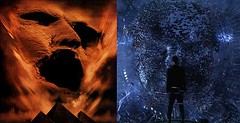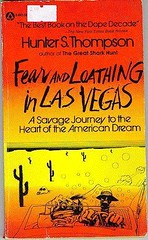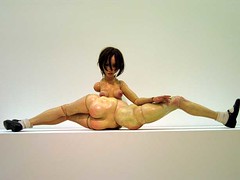Wednesday, February 23, 2005
Tuesday, February 22, 2005
Two bits.
Monday, February 21, 2005
Boring weekend highlights
Cinema shorts:
Sunset Boulevard struck me as a curiosity--could Oscar-winning movies from 1950 be this weird? What has happened since then?--but not particularly good. David Lean's Brief Encounter, recently reissued by Criterion, didn't connect either: handsome, but little else to recommend it. The Matrix Revolutions--thankfully stripped of its freshman-philosophy-driven plot stylings, replaces tedium with, um, implausible mechano-diplomacy by Keanu to defeat the army of Ray-Ban-clad Agent Smiths. Whatever. At least Underworld--barely interesting enough to make it past the first of many expected voiceovers--promises Kate Beckinsale in fetish knickers.
In print:
Continuum Books (New York and London) has released another eight titles from their worthy Thirty-Three and a Third series, a collection of short books on personal and critical fave LPs from the last forty years (head here for a full accounting). Cindy came back from CAA's book fair bearing Bill Janovitz's examination of Exile On Main Street, a seminal and timeless record from my youth and, it turns out, a breezy and smart read. Barely a dozen pages into the thing and the author is already discussing photographer Robert Frank's album design and its connection to 1970s America, Jagger's musical influences and savvy, a call-and-response initiated by Joe Strummer, and the album's connection to Los Angeles. Based on the quality of the other volumes I've read--the well-written account of Neil Young's recording of Harvest is concerned with studio culture, and the Beatles' Let It Be looks at the motivations that brought the group into Twickenham, and their emotional lives as the record was coming together and being recorded--they're perfect for an on-line look at the DMV. (Upcoming: David Bowie's Low!)
From A Chance Meeting: Intertwined Lives of American Writers and Artists, a lovely book of small gems; available for $5.98 at Daedalus Books (Baltimore's best bookstore), on the relationship between Joseph Cornell and Marianne Moore:
Once, he sent her a valentine in April. . . . [It] was actually a package and contained a few sheets of unusual "worm-work" paper that he'd found and thought she might appreciate. He also enclosed two ancient books, one on rare animals, that seem to have been exactly to her taste. The books "would make any valentine seem dull," she wrote in enthusiastic reply.
TV:
Hillary on the chat shows. (She'd be a disastrous nominee, but is an increasingly effective opposition leader.) Huzzah!
Hunter Thompson is dead at 67.
Many obits will focus on his colorful nature, his departed skills, or his substance abuse and depression, but I will state, simply, that Hunter Thompson was a pleasure to read--one of the few writers who ever led me to laugh out loud.
In a culture where there's profound anxiety about what's good for you and what's not--cf. my sermons on the wrongheaded-ness of television-hatred--one may get confused about proffered advice about books, too: all reading is good (just as all television is bad), so there's a bit of performance anxiety involved. As a youth, then, one picks up these "essential" books--say, Zen and the Art of Motorcycle Maintenance or the Lord of the the Rings--and we're relieved to get through them (when we can).
It was never difficult to "get" him. And, yet, Thompson invited us into foreign parts: the world of outlaws, into the political trenches, on a "savage journey to the heart of the American dream"; after finishing a report from the Rolling Stone National Affairs desk, one was immediately anxious for the next dispatch. I purchased a paperback edition [inset; I still have the worn-out original in a Ziploc bag at my desk] of Fear and Loathing in Las Vegas as a teenager, at an O'Hare newsstand as a blizzard shut down the airport, on my way to a bus bound for Moline, Illinois, close to where my family was living at the time; I had finished the novel before I arrived in the Quad Cities. His political writing in the 1970s was unlike anything I had ever read; a liberal, he never pulled punches:There is no way to grasp what a shallow, contemptible and hopelessly dishonest old hack Hubert Humphrey is until you've followed him around for a while.
I went through the two volumes of his letters (Proud Highway and Fear and Loathing in America) last summer and was interested to see how thoughtful and determined he was to succeed; tender letters to his mom and old friends were surprising, too.
Thompson admired Neil Young's work--among other connections, Young scored Where the Buffalo Roam--and HST elected to burn out rather than rust. An inspiration and an original voice, never mind the down-stroke: May he rest in peace.
Postscript: a nice piece on HST by the Chronicle's David Kipen that highlights the writing. [cws::23 Feb]
P.P.S.: another rememberance that has no silliness. [cws::25 Feb]
Wednesday, February 16, 2005
The lost museum

The Lost Museum--a virtual reproduction of P. T. Barnum’s American Museum, the pre-eminent cultural institution of nineteenth century America--has been created by the American Social History Project in collaboration with the Center for History and New Media at George Mason University and produced at the New Media Lab at the City University of New York Graduate Center. Funded by the National Endowment for the Humanitites and others, the website includes a QuickTimeVR 3-D tour of the original building, complete with exhibition close-ups; a searchable archives with posters, pamphlets, and original guidebooks to the attraction; and a section for teachers and students that includes essays on a wide variety of topics, including "Barnum's American Museum," "Urban Popular Culture in the Age of Barnum," and "Fame and Fortune: The Marketing of Celebrity."
The literature of wonder is a great interest of mine, and this resource contains a wealth of material on the topic. Go ahead: gawk at the Siamese twins and the FeJee Mermaid!
Tuesday, February 15, 2005
(It's not blood)
Monday, February 14, 2005
Weekend highlights: Muff confetti et alia
Cinema.
- A bit of a mess, Olivier Assayas's Demonlover (2003) manages to convey an internal logic that pulled me in, even if I didn't always understand what was happening. More stylish and knowing that David Cronenberg's eXistenZ, which it resembles, it's important to surf the film without becoming too literal-minded--unfortunately, the deeply unsatisfying conclusion spends much of the goodwill that has accrued along the way.
Two movies that are far from perfect, yet perfectly cinematic [a quality that goes a long way towards atoning for their sins]:
- Great production design and strong performances by William Macy and Maria Bello recommend Wayne Kramer's The Cooler (2003) despite the fact that it's sometimes difficult to buy crucial plot points--Alec Baldwin got good reviews for his role as the old-school casino boss (a great role, with colorful language--I was smiling minutes after he tosses off "muff confetti"), but I didn't care for his performance. The love scenes are particularly striking for their improbability and verity, and as the movie shakes off its self-consciousness, it's a good ride.
- Jean-Pierre Jeunet's A Very Long Engagement (2004) is, of course, beautiful. From the opening titles--lovingly run over a barely illuminated, rain-slicked wall--to the evocative ochres and siennas that color the frame, David Edelstein nailed the film as he offered that it might be titled "Amélie Goes to War."
Print.
- "The rule-benders," David Jury's feature from the current issue of Baseline--"the leading international magazine about type and typography"--is yet another in a series of reminders of the font of modernity that is the late nineteenth century; he provides stunning images of a compositor's sketchbook, evidence, says Jury, of "doing exactly what any 21st century student of graphic design should be encouraged to do." (The journal is pricey, but one can linger at Borders and gawk.)
Music.
- A half-dozen new releases from Sublime Frequencies over the past week or two, and my favorite thus far is Radio Phnom Pehn, a fantastic pastiche of selections pulled directly from the Cambodian airwaves--I'm a big fan of all of SF's "radio" disks, including Radio India and Radio Morocco, the latter a superlative collection assembled from 1983 recordings, when Michael Jackson ruled the world music roost (actually, he still does--I was resting in Delhi's Red Fort complex in 1998 when locals, working the refreshment stand, discovered I was American and excitedly fetched and played a cassette recording of Thriller for me).
- Even wackier is the second volume of Thai Beat A Go-Go from Subliminal Sounds: think pop songs that are off-key in a barely perceptible way; there's one selection that reminds me of the Hokey Pokey, plus an insanely cool collection of fucked-up covers (try a Thai Elvis, Tony Orlando, or Hank Williams on for size, to begin with), and the brilliant "I Find Only Dream" that wouldn't be out of place in a David Lynch soundtrack. Now I've gotta scare up volume one...
Friday, February 11, 2005
P.S.
Temples
Many smarter than I (Hans Belting is a favorite) are fond of reminding us that the museum has changed, radically, in pomo times: it is seldom the temple that it once was, where one visited canonical artworks that one's parents visited. (It now serves as, among other things, a site for mind-expansion, entertainment, and the primary place where art discourse is practiced--fodder for another discussion. Sometimes cognition leads one away from contemplation.)
In January I had the good fortune to visit the Centre Pompidou, perhaps the great temple of modernism, and I was reacquainted with many old friends and introduced to some new ones. Some familiar favorites:
- Anselm Kiefer's beautiful, lyrical, and rigorous Secret Life of Plants (0 1 2 3 4 5 6 7 8 9) document the Western artist-scientist's attempt to encompass all of knowledge within the bounds--actually, sometimes exceeding the bounds!--of the canvas.
- The exquisite quiet of Joseph Beuys's Plight (0 1 2 3), a grave, tomblike space that smells of felt--great rolls of the material fill the room--and contemplates loss.
- Kasimir Malevitch's great iconic Black Square and Black Cross; with staggering foresight (1915! Christ!), pinning down the ephemeral religious impulse for all to see.
- Jean Dubuffet's groovy and inviting Winter Garden installation.
- "Breton's Wall": the great surrealist provides a glimpse into an active mind (the Pompidou's website provides an encyclopedic inventory of the Wall's contents).
- I guess it makes sense that the French would take Jean Tinguely more seriously than we do, but I've always enjoyed their collection of his work, especially the self-destructing sculptures (I couldn't find them this time, but enjoyed Requiem pour une feuille morte, a really cool outsized diorama).
But there were exciting discoveries, too, foremost among these a fantastic exhibition by Thierry de Cordier, Belgium's representative to the 1997 Biennale. A small projects space was filled with more than a hundred of de Cordier's drawings and two of his sculptures, coffinlike structures he likens to "shelters." The drawings (samples here: 0 1 2) incorporate photographs, collage, letters, poetry, and type, but almost always concern the land--many of them depict falling snow, and are concerned with forms of de Cordier's shelters (samples here: 0 1 2). [For those interested in more images, but I purchased the beautifully executed and bound exhibition catalog.] One of my favorites was a pine "shelter," blackwashed, with an old 78rpm phonograph record incorporated at the end, so one could look inside the box. The feeling that something profound was occupying the gallery was unshakeable and inspirational.
Two paintings from 1933 by Balthus, Alice and La toilette de Cathy, were terrific.
Finally, on display was La poupée [inset], one of Hans Bellmer's dolls (museum images here: 0 1 2 , but they're not very good quality); I'm not very familiar with Bellmer's work, but the sculpture is reason enough to dig. This beautiful and disturbing subject of Bellmer's photographs--along with Balthus's work--promises a complex and human treatment of sexuality.
Monday, February 7, 2005
Weekend top five
- New work by Seth Adelsberger at Current on Friday nite.
- Reading/performance by Lauren Bender at Once.Twice:Sound on Saturday nite.
- John Walter's How to Draw a Bunny, a documentary on the life and death of mail artist Ray Johnson (available on DVD at Video Americain).
- Lars von Trier and Jørgen Leth's Five Obstructions, an extension of von Trier's Dogme 95 experiments and his monumental ego; Leth is a treasure (available on DVD at Video Americain).
- On the drive into work this AM: Amp Fiddler's "Superficial" on the iPod.






































